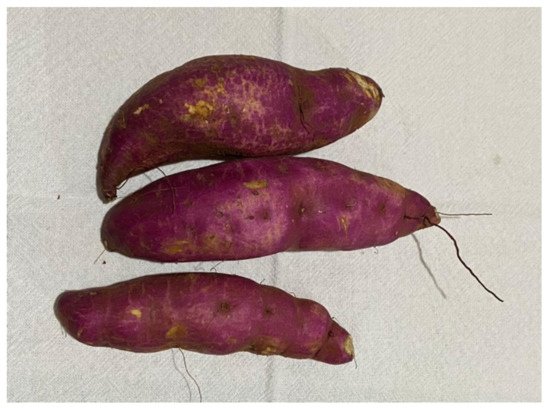Your browser does not fully support modern features. Please upgrade for a smoother experience.
Please note this is an old version of this entry, which may differ significantly from the current revision.
Subjects:
Agronomy
Sweet potatoes (Ipomoea batatas L.) are part of the largest food crops in many countries. It has good nutritional value because, in addition to containing vitamins, minerals, carotenoids, and anthocyanins in varied contents, due to the existence of various colors of their pulps, they have starch as their major constituent.
- Sweet potato (Ipomoea batatas L.)
1. Introduction
Sweet potato (Ipomoea batatas L.) is a tuberous root from Central and South America that has great economic importance and is easy to grow [1]. It has high nutritional value, with starch as its major component (70–80% d.w.), in addition to fibers, proteins, vitamins, minerals [2], and bio components (such as carotenoids, phenolics, and anthocyanins) [3]. Its pulp can display white, beige, orange, purple, and other colors [4], and its starch granules may exhibit different morphologies and pasting properties, presenting the potential for application in different products [5]. These differences, in both morphology and properties, may be associated with the cultivar, climatic conditions, and physiology of the sweet potato plant [6,7]. In this way, its starch (or its flour) is widely used in some countries, such as China, as ingredients in the food industry for contributing to the textural properties of soups, sauces, pasta, bread, and snacks [2,8,9].
Starches in native form have limitations of use in the food industry, such as instability to changes in temperature and tendency to retrograde. Thus, the modification of native starches has been studied to expand and improve the use [12]. Modification methods that do not use chemicals are the most attractive today [13] because they do not harm the environment [14], among them, are the autoclave modification methods [15] and fermentation [16]. Products modified by these methods (starch or flour) can be used as ingredients in food formulations, unlike those resulting from chemical methods that are classified as additives [17].
2. Sweet Potatoes (Ipomoea batatas L.)
Sweet potato (Ipomoea batatas L., Convolvulaceae) is a crop of great nutritional importance (Figure 1) after rice, maize, wheat, potatoes, millet, and cassava [3]. It is grown in many tropical and subtropical countries, such as Asia, Africa, and Latin America. They are dicotyledonous plants belonging to the Convolvulaceae family, in which there are approximately 50 genus and more than 1000 species [25]. The composition and content of nutrients in cultivars vary widely; depending on genetic and environmental factors [26]. Its cultivation is not seasonal, having a short vegetative cycle (3.5 to 5.5 months) and good adaptability to various climates and agricultural systems, which allows its wide supply and low cost [27,28].

Figure 1. Sweet potato, Ipomoea batatas L. Source: Personal archive.
Sweet potato presents diversified nutritional properties due to its white, beige, purple, and orange pulps [8], as well as variation in the content of its components, on a dry basis, such as starch (42.4–77.3%), crude fiber (1.9–6.4%), protein (1.3–9.5%), ash (1.1–4.9%), lipids (0.2–3.0%), and total sugar content, which is approximately 3.8%, with sucrose, maltose, and glucose representing the predominant free sugars, which provide the sweet taste of this tuberous root [3]. It is usually consumed roasted, boiled, steamed, or fried as direct food [29].
It is also considered a highly nutritious vegetable because it contains vitamins (such as vitamin C, riboflavin, pyridoxine, and tocopherol), minerals (such as zinc, potassium, magnesium, copper, calcium, and iron), and fibers (such as pectin, cellulose, and hemicellulose). Depending on the color of its pulp, it has an expressive content of bioactive compounds, such as carotenoids, phenolic acids, and anthocyanins [9,13].
Carotenoids and anthocyanins are pigments synthesized by plants and are fat-soluble and water-soluble, respectively. The former is responsible for the yellow to orange colors, and the latter for the light pink to purple colors. Both can be used in foods, such as dyes, flavorings, and nutritional supplements [30]. Carotenoids are polyisoprenoid compounds classified into hydrocarbon carotenes (such as β-carotene) and xanthophylls [31].
Phenolic compounds are antioxidant molecules with at least one aromatic ring and one or more hydroxyl groups; flavonoids are a group of phenolics that consists of two aromatic rings linked by three carbons that are in an oxygenated heterocyclic ring [32,33]. As simple phenols, there are derivatives of hydroxycinnamic acid, and as polyphenols (or flavonoids), there are anthocyanins [31,34].
This entry is adapted from the peer-reviewed paper 10.3390/polysaccharides2020023
This entry is offline, you can click here to edit this entry!
